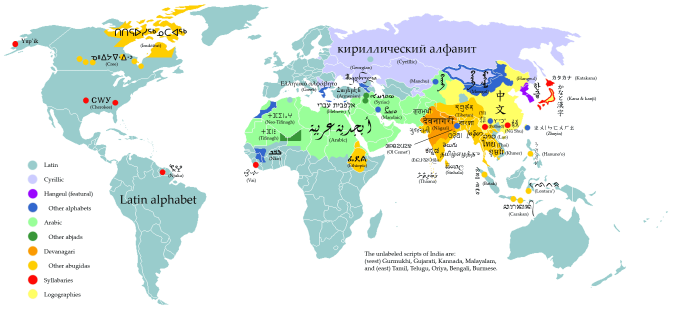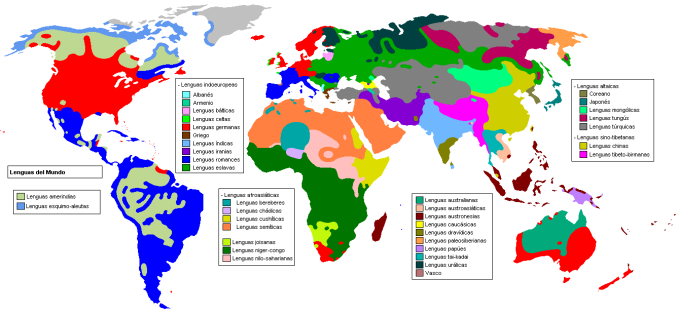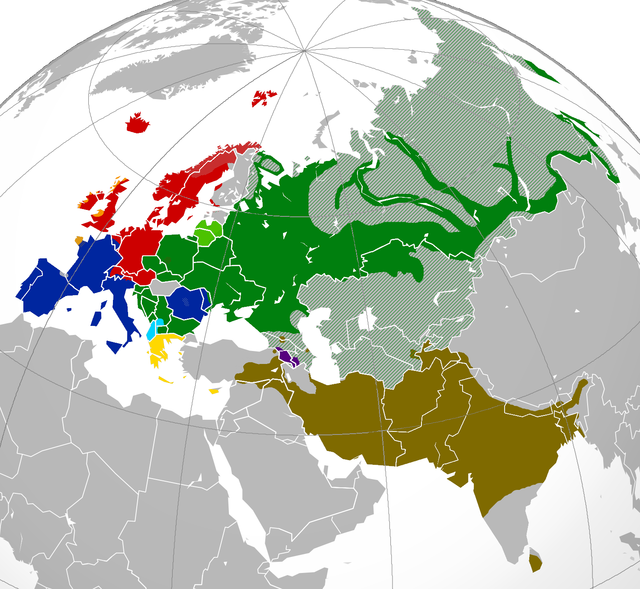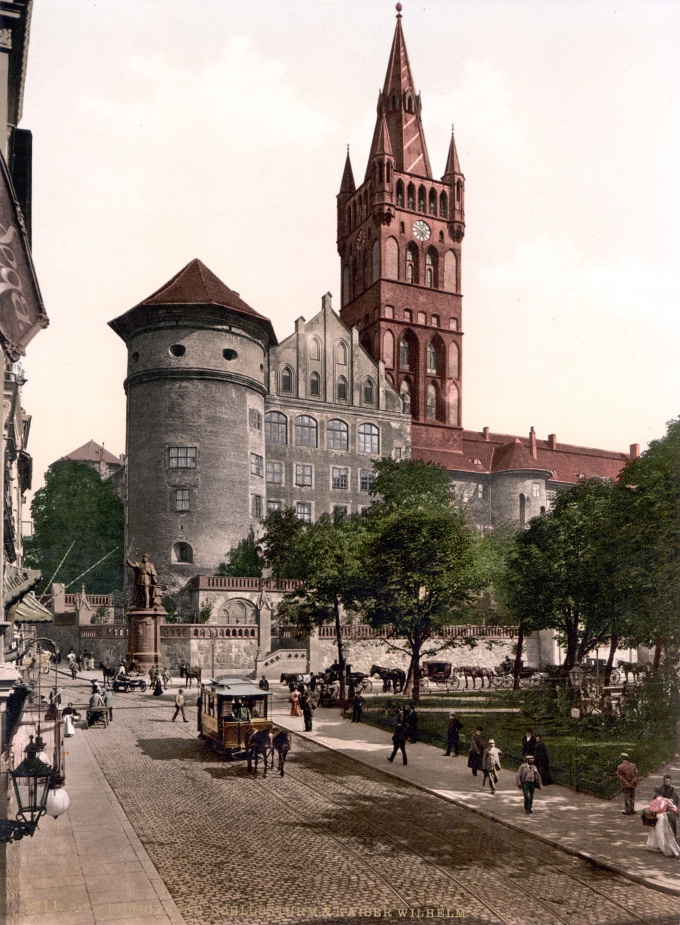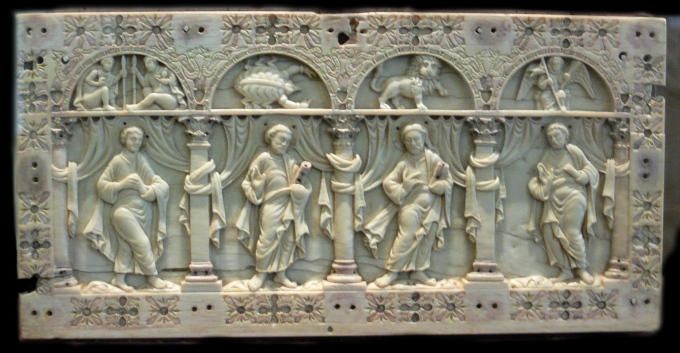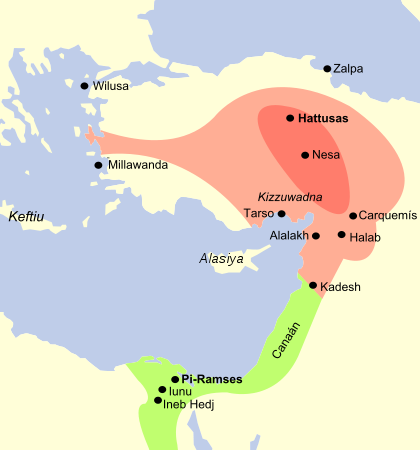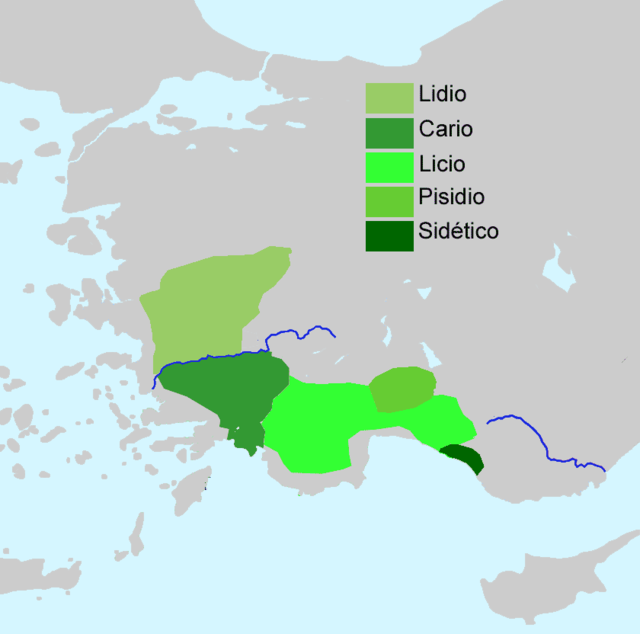Tradicionalmente, el indoeuropeo se clasificaba en dos grupos: lenguas satem y lenguas centum, que recibieron esos nombres dependiendo de si la serie de fonemas velares protoindoeuropeos /*k, *g, *gh/ se palatalizaba (*kntom ‘[el número] 100′ es en avéstico satem) o no (*kntomdio en latín centum). Sin embargo, hoy en día no se concede apenas importancia al cambio (uno entre tantos), ni se cree que sea un criterio sólido que clasifique adecuadamente a las lenguas indoeuropeas. De hecho, varias clasificaciones que tratan de reconstruir el árbol cladístico de las lenguas indoeuropeas ni siquiera consideran a las lenguas satemcomo una rama propiamente.7 8 Eso sugiere que la palatalización se extendió entre lo que eran diferentes ramas de la familia.
La primera rama que se separó del tronco común fue la rama anatolia y algo más tarde la rama tocaria, ambas ramas están actualmente extintas (sin descendientes hablados actualmente). Estas dos ramas no presentan la típica palatalización de las lenguas satem, incluso cuando el tocario es una rama “oriental”. De hecho es la única lengua oriental que no palataliza, lo cual sugiere que la palatalización en la que se basa la división centum / satem es relativamente tardía. Las subdivisiones restantes son algo más discutidas, aunque parece claro que el griego, el armenio y probablemente otras lenguas paleobalcánicas formarían juntas una subdivisión. Esta rama greco-armenia incluye tanto lenguassatem como lenguas centum, razón por la cual se considera que la división satem–centum no es adecuada, dado que ninguna de las dos subdivisiones seríanramas cladísticas propiamente dichas.
Subdivisiones principales
La familia de lenguas indoeuropea se subdivide a su vez en grupos, estos son:
- Lengua albanesa
- Lengua armenia
- Grupo anatolio
- Grupo balcánico
- Grupo báltico
- Grupo celta
- Grupo eslavo
- Grupo germánico
- Grupo griego
- Grupo indoiranio
- Grupo itálico
- Grupo tocario
Las relaciones internas entre estos grupos de último nivel son algo más complicadas y polémicas y todavía existen discrepancias menores. Por ejemplo, aunque universalmente se reconoce una especial relación entre el grupo griego y algunas lenguas paleobalcánicas (en particular elarmenio), no está claro por ejemplo si las lenguas indoarias se formaron por una división de un hipotético proto-indoeslavo o, por el contrario, deben considerarse el resultado de la escisión de un hipotético proto-indogriego. Y problemas similares se encuentran con las lenguas germánicas, las lenguas eslavas, las lenguas celtas o las lenguas itálicas.
Recientemente han aparecido dos intentos de clasificación interna agrupando los subgrupos básicos anteriores: El árbol filogenético de Gray-Atkinson (The ‘New Zealand’ family tree, 2003) y el árbol filogenético de Ringe-Warnow-Taylor (The ‘Pennsylvania’ family tree, 2002). El primero se basa estrictamente en léxico compartido y substituido, mientras que el segundo se basa en isoglosas fonológicas y morfológicas. Aunque ambas clasificaciones presentan algunos puntos comunes, también difieren de manera importante en otros detalles. Las ramas marcadas con (†) corresponden a ramas o lenguas extintas que dejaron de tener hablantes nativos. El árbol de Gray-Atkinson tiene la siguiente forma:9
| proto-IE1 |
|
||||||||||||||||||||||||||||||||||||||||||||||||||||||||||||||||||
El árbol de Ringe-Warnow-Taylor, que deja fuera a las lenguas germánicas, ya que considerarlas implica que no existe un árbol de ajuste óptimo (es decir, filogenéticamente perfecto), tiene la siguiente forma:10
| proto-IE1 |
|
||||||||||||||||||||||||||||||||||||||||||||||||||||||||||||
En un trabajo posterior Ringe-Warnow-Evans-Nakhleh usaron 292 caracteres (parámetros de comparación) y emplearon redes filogenéticas en lugar de árboles (bajo la hipótesis de homoplasia, desarrollo independiente y otras) llegando a una red filogenética muy similar al árbol anterior, que incluía tres “ramas” de contacto (en rojo):11
Lenguas satem
Existen dudas de que las lenguas satem constituyan una unidad filogenética válida dentro del indoeuropeo, como una vez se pensó. Si los árboles filogenéticos propuestos por Ringe y Warnow son correctos, las lenguas satem constituirían una unidad filogenética (a diferencia de las lenguas centum, que serían el resto de lenguas que no formarían un grupo filogenético válido).
- Lenguas balcánicas meridionales (Grupo frigio-armenio):12armenio, frigio (†), peonio (†).
- Lenguas balcánicas septentrionales (grupo daco-tracio, albanés):albanés, dacio (†), tracio (†).
- Lenguas bálticas: prusiano antiguo (†), letón, lituano
- Lenguas indoiranias:
- Lenguas indoarias:
- indoiranio antiguo y medio: sánscrito, prácrito (†).
- moderno indoario: assamés, bengalí, cingalés, guyarati del norte, guyarati del sur, hindi–urdu, maratí, nepalí, panyabí central, romaní, sindhi, cachemir, bhili,chatisgarí, oriya,kumhali
- Lenguas iranias:
- Antiguas: persa antiguo (†), avéstico (†), medo (†), escita (†).
- Medias: sogdiano (†), kotanés (†), bactriano (†), parto (†),pahlavi (†), persa medio (†).
- Modernas: beluche (baluchi), kurdo, pastún, persa moderno,tayiko, osetio/iron/digorés
- Lenguas dárdicas
- Lenguas nuristaníes
- Lenguas indoarias:
- Lenguas eslavas
Lenguas centum
Las lenguas centum no constituyen una unidad filogenética válida dentro del indoeuropeo, como una vez se pensó. Ya que entre estas lenguas se encuentra tanto el grupo anatolio que fue la primera rama en diferenciarse del indoeuropeo como lenguas que solo más tarde se diferenciarían entre sí. Dicho de otra manera, no sería posible reconstruir un “protocentum” que por diversificación hubiera dado lugar a las lenguas centum que fuera diferente del protoindoeuropeo común. En ese sentido, la clasificación en lenguas centum obedece más a hechos accidentales y convencionales, que a un hecho lingüístico estricto. Las lista de lenguas centum es la siguiente:
- Lenguas anatolias (†): hitita (†), lidio (†), licio (†), luwita (†), pisidio(†), sidético (†).
- Lenguas celtas
- Lenguas celtas continentales: galo (†), celtíbero (†), lepóntico (†).
- Lenguas goidélicas (gaélicas): manés (†), gaélico irlándes, gaélico escocés
- Lenguas britónicas: córnico (†), bretón, galés.
- Lenguas germánicas
- Germánicas occidentales: Inglés antiguo o anglosajón (†), inglés,escocés (scots), lenguas frisonas, alemán estándar (alto alemán),luxemburgués, yiddish, bajo alemán, neerlandés, afrikaans.
- Germánicas orientales: gótico (†), gótico de Crimea (†).
- Germánicas septentrionales: Escandinavo antiguo (†), islandés,feroés, neonoruego (nynorsk), norn (†), noruego (bokmaal, riskmal), danés, sueco, dalecarniano,gútnico antiguo (†)
- Lenguas helénicas: griego clásico, griego moderno.
- Lenguas itálicas:
- Lenguas osco-umbras (†): osco (†), umbro (†).
- Lenguas latino-faliscas antiguas: falisco (†), latín (†).
- Lenguas romances:
- Lenguas iberorrománicas: español, gallego–portugués,asturiano-leonés, aragonés.
- Lenguas occitanorromances catalán, occitano–gascón
- Lenguas galorrománicas: francés, franco-provenzal.
- Lenguas retorrománicas: romanche, friulano, ladino.
- Lenguas galoitalianas: ligur, piamontés, lombardo, emiliano-romañol, véneto.
- Lenguas italorromances: italiano estándar, romanesco,napolitano, siciliano, corso-gallurés.
- Lenguas balcorrumanas: rumano estándar, meglenorrumano,istrorrumano.
- Lenguas romances insulares: sardo, antiguo corso.
- Otras lenguas romances extintas: dálmata, mozárabe.
- Lenguas tocarias (†): tocario A (†), tocario B (†).
- Lusitano (†).
Parentesco con otras lenguas
Actualmente no existe una evidencia incontrovertible de que las lenguas indoeuropeas muestren un parentesco claro con lenguas de otras familias, aunque existe un cierto número de propuestas tentativas que sugieren que es posible reconocer el parentesco lejano de las lenguas indoeuropeas con otras familias lingüísticas de Eurasia. Lahipótesis nostrática (Pedersen, Illič-Svityč y Dolgopolsky) y la hipótesis euroasiática de Greenberg sostienen que las lenguas urálicas, laslenguas afroasiáticas y otras muestran un parentesco reconocible con elprotoindoeuropeo y que es posible reconstruir parcialmente laprotolengua de la que descienden estas familias.
Sin embargo, estas hipótesis han encontrado un alto grado de criticismo13 14 y no tienen aceptación general actualmente, aunque los partidarios de estas hipótesis han continuado con el trabajo comparativo en favor de la misma.
________________________………………………………….==========================
Classification of Indo-European languages
Traditionally, the Indo-European was classified into two groups: satem languages and languages centum , who received those names depending on whether the number of velar phonemes protoindoeuropeos / * k, * g, * g h/ is palatalizaba ( * kntom ‘[number] 100 ‘is in Avestan satem ) or not (* kntom gave Latin centum ). However, today only important to change (one of many) is not granted, nor is believed to be a solid criterion that adequately classify Indo-European languages. In fact, several classifications trying to rebuild the cladistic treeof Indo-European languages do not even consider the languages satem as a branch proper.7 8 This suggests that palatalization spread between what were different branches of the family.
The first branch to split from the common trunk was the Anatolian branch and somewhat later the Tocharian branch , both branches are now extinct (no descendants currently spoken). These two branches do not exhibit the typical palatalization languages satem even when Tocharian is an “oriental” branch. In fact the only oriental language not palatalized, suggesting that palatalization in which the division is basedcentum / satemrelatively late. The remaining subdivisions are somewhat disputed, but it seems clear that the Greek, Armenian and probably other languages paleobalcánicas together form a subdivision. This Greek-Armenian branch includes both languages satem as languages centum , which is why it is considered that the divisionsatem – centum is not adequate, since neither would subdivisions cladistic branchesthemselves.
Major subdivisions
The family of languages Indo-European is subdivided into groups, these are:
- Albanian Language
- Armenian Language
- Anatolian Group
- Balkan Group
- Baltic Group
- Celtic Group
- Slavic group
- German Group
- Greek group
- Indo-Iranian Group
- Italic Group
- Tocario Group
Internal relations between these groups last level are more complicated and controversial and there are still minor discrepancies. For example, although universally a special relationship between the recognizedGreek group and some paleobalcánicas languages (in particular theArmenian ), it is not clear for example if the Indo-Aryan tongues are formed by a division of a proto-indoeslavo hypothetical or, conversely should be considered the result of cleavage of a hypothetical proto-Indo-Greek. And similar problems are found with the Germanic languages, Slavic languages, the Celtic languages or the Italic languages.
Recently there have been two attempts at internal classification grouping the above basic subgroups: The phylogenetic tree of Gray-Atkinson ( The ‘New Zealand’ family tree , 2003) and phylogenetic tree Ringe-Warnow-Taylor ( The ‘Pennsylvania’ family tree , 2002). The former is based strictly on shared lexicon and replaced, while the second is based on isoglosses phonological and morphological. Although both classifications have some commonalities, they also differ significantly in other details. The branches marked with (†) are branches or extinct languages ceased to be native speakers. Gray tree-Atkinson has the following form: 9
| proto-IE1 |
|
||||||||||||||||||||||||||||||||||||||||||||||||||||||||||||||||||
The tree Ringe-Warnow-Taylor, which leaves out the Germanic languages, and to consider them implies that there is a tree of best fit (ie, phylogenetically perfect ), has the following form: 10
| proto-IE1 |
|
||||||||||||||||||||||||||||||||||||||||||||||||||||||||||||
In later work Ringe-Warnow-Evans-Nakhleh used 292 characters (comparison parameters) and used phylogenetic networks rather than trees (under the hypothesis of homoplasy, independent development and others) reaching a phylogenetic network similar to the previous tree which included three “branches” of contact (in red): 11
Languages satem
There are doubts that satem languages represent a valid phylogenetic unit within the Indo-European as once thought. If the phylogenetic tree proposed by Ringe and Warnow are correct, the tongues constitute a phylogenetic satem unit (unlike centum ones, such other languages that do not form a valid phylogenetic group).
- Southern Balkan languages (Group Phrygian-Armenian): 12Armenian , Phrygian (†), peonio (†).
- Balkan languages Northern (Daco-Thracian group, Albanian):Albanian , Dacian (†), Thracian (†).
- Baltic languages : Old Prussian (†), Latvian , Lithuanian
- Indo-Iranian languages :
- Indo-Aryan languages :
- Old and Middle Indo-Iranian: Sanskrit , Prakrit (†).
- Modern Indo-Aryan: Assamese , Bengali , Sinhalese , guyarati North , South guyarati , Hindi – Urdu , Marathi , Nepali , Punjabi Central , Roma , Sindhi , Kashmiri ,Bhils , chatisgarí , Oriya ,kumhali
- Iranian languages :
- Ancient: Old Persian (†), Avestan (†) medo (†), Scythian (†).
- Medias: Sogdian (†), Khotanese (†), Bactrian (†), childbirth (†),Pahlavi (†), Middle Persian (†).
- Modern: Beluche ( Baluchi ), Kurdish , Pashto , Farsi , Tajik ,Ossetian / iron / digorés
- Dárdicas Languages
- Nuristanis Languages
- Indo-Aryan languages :
- Slavic Languages
- South Slavic : Bosnian , Bulgarian , Croatian , Slovenian ,Macedonian , Serbian , Old Church Slavonic (†).
- Western Slavic
- Eastern Slavic : Russian , Belarusian , Ukrainian , Ruthenian (†),Rusyn .
Centum languages
The centum languages are not a phylogenetic unit within the Indo valid as once thought. As between these languages is both the Anatolian group was the first branch of Indo-European as languages differ only later differentiate each other. Put another way, it would be possible to reconstruct a “protocentum” diversification that would have led to the centum languages were different from the common Proto. In that sense, the classification in centum languages due more to accidental and conventional facts that a strict linguistic fact. The centum languages list is as follows:
- Anatolian languages (†): Hittite (†), Lydian (†), silicon (†), luwita(†), Pisidian (†), sidético (†).
- Celtic Languages
- Continental Celtic languages : French (†), Celtiberian (†), Lepontic(†).
- Goidelic languages (Gaelic) : Manx (†), Irish Gaelic , Scottish Gaelic
- Brythonic languages : Cornish (†), Breton , Welsh .
- Germanic languages
- West Germanic : Old English or Anglo-Saxon (†), English , Scots (Scots) , Frisian languages , German (High German) standard ,Luxembourg , Yiddish , Low German , Dutch , Afrikaans .
- Eastern Germanic : Gothic (†), Crimean Gothic (†).
- Northern Germanic : Old Scandinavian (†), Icelandic , Faroese ,neonoruego (nynorsk) , norn (†), Norwegian (bokmaal, riskmal) ,Danish , Swedish , dalecarniano ,old gútnico (†)
- Hellenic languages : Ancient Greek , Modern Greek .
- Italic languages :
- Osco-Umbrian languages (†): Osco (†), Umbria (†).
- Faliscas languages Latin Ancient : falisco (†), Latin (†).
- Romance languages :
- Ibero-Romance languages : Spanish , Galician – Portuguese ,Asturian-Leonese , Aragonese .
- Occitanorromances languages Catalan , Occitan – Gascon
- Galorrománicas languages : French , Franco-Provençal .
- Retorrománicas languages : Romansh , Friulian , Ladin .
- Galoitalianas Languages : Ligurian , Piedmont , Lombardy ,Emilia-romañol , Veneto .
- Italorromances Languages : standard Italian , Romanesco ,Neapolitan , Sicilian , Corsican-gallurés .
- Balcorrumanas Languages : Romanian standard , meglenorrumano, Istro-Rumanian .
- Island Romance languages : Sardinian , Corsican old.
- Other languages extinct romances: Dalmatian , Mozarabic .
- ‘d Play Languages (†): Tocharian A (†), Tocharian B (†).
- Lusitano (†).
Relationship to other languages
Currently there is no incontrovertible evidence that Indo-European languages show a clear relationship to languages of other families, although there are a number of tentative proposals that suggest it is possible to recognize distantly related Indo-European languages to other language families of Eurasia . The Nostratic hypothesis (Pedersen,illic-Svityčand Dolgopolsky) and Eurasian Greenberg hypothesis argue that the Uralic languages , the Afro-Asiatic languages and others show a recognizable relationship to PIE and it is possible to partially reconstruct the proto-language from which these families descend .
However, these hypotheses have found a high degree of criticism 13 14and have now well accepted, although proponents of these hypotheses have continued with the comparative work for it.
Fuente:


